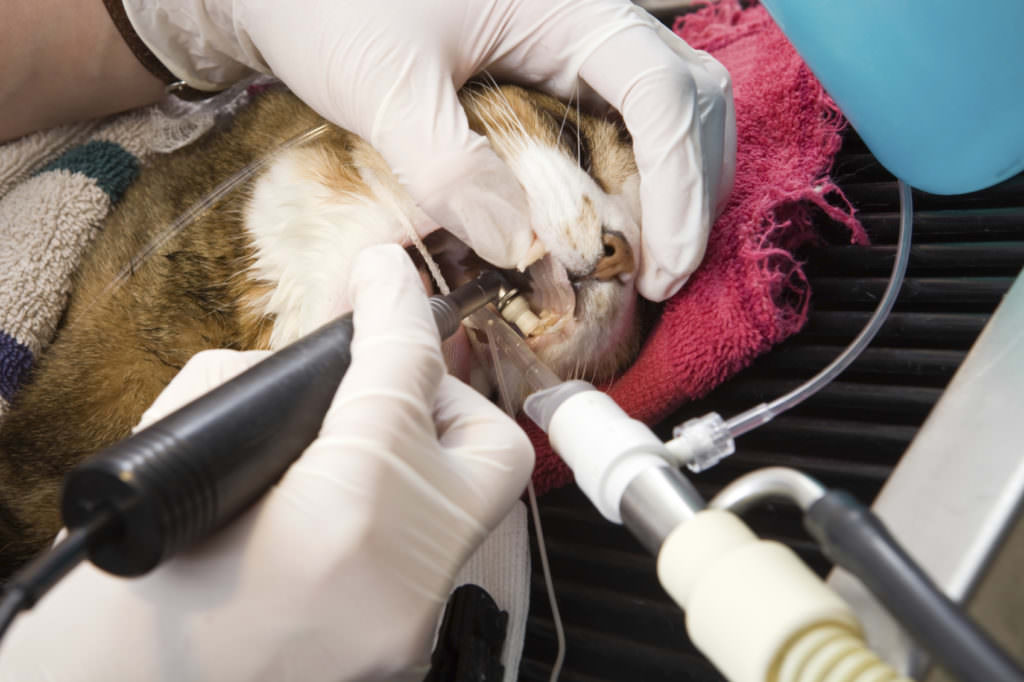In honor of National Pet Dental Health Month, we wanted to give you an “inside” look into what happens when your cat goes in for a dental check-up. A complete oral exam and a therapeutic dental cleaning are vital to keeping your cat healthy.
Why?
Because plaque and tartar build-up, especially under the gum line, needs to be removed regularly to prevent tooth decay, gum inflammation, and periodontal disease.
How?
A professional dental cleaning is a complex procedure and can only be performed at your veterinarian’s clinic. This is because a general anesthetic is required to adequately examine and clean each tooth and hard-to-reach places, like under the gumline. (Imagine trying to clean under your pet’s gums while they are awake—it would be impossible to keep them still!)
To make at-home dental care part of your pet’s routine, ask your veterinary healthcare team to recommend products that best suits your lifestyle.

What happens during a therapeutic dental cleaning?
The following table was provided by Canadian Animal Health Institute to help pet owners better understand the benefit for a routine dental exam and cleaning:
| Examination and Evaluation | After your pet has been safely anaesthetized, a thorough oral examination is performed by your veterinary team. This includes probing each tooth and documenting all findings in the pet’s dental chart. |
| Dental X-rays | These radiograph images help your veterinarian make a more accurate evaluation of your pet’s oral health by revealing issues that are invisible to the naked eye. |
| Scaling | This process removes all tartar and plaque from the teeth and from under the gumline. The same type of instruments your dentist uses on your teeth (scalers and curettes) will be used. |
| Polishing | The cleaning process can leave a rough finish that can trap plaque. Polishing will smooth out tooth surfaces and make it harder for plaque to come back. |
| Irrigation | After the teeth have been cleaned and polished they are rinsed to remove any remaining debris. It is important that no debris, such as polishing paste, be left under the gumline. |
| Sealing the surfaces of the teeth | A sealant may be applied to your pet’s teeth to help protect the enamel and prevent tooth decay. |
Benefits of a professional dental cleaning:
- Removes plaque build-up above and below the gumline
- Identifies problems that should be addressed (includes recommending surgery)
- Prepares the teeth for tartar prevention and home dental care

FAQs
We asked Dr. Fraser Hale, a veterinary dental specialist from Hale Veterinary Clinic, to answer the following common questions about cat dental health.
Why shouldn’t an owner assume that because they feed their cat dry food, its teeth are being cleaned when they eat and they don’t need to do anything further?
Dr. Hale: There are only very few diets that offer any dental benefit at all and owners should visit www.vohc.org to find a list of such diets. Aside from these few, owners should have no expectations that whatever foods they feed [their cats] do anything for maintaining good oral hygiene and health. Even the very best dental diets are only ever a part of the oral care plan and owners must not have unreasonable expectations for what they can accomplish.
What are some of the risks associated with not taking your cat in for a regular dental cleaning?
Dr. Hale: First, I think it is essential that readers are aware that optimizing oral health is about a lot more than just dental cleanings. The risk of not taking your cat in for regular professional dental assessments and treatment is that small problems become big problems and your cat will suffer in silence from hidden and painful dental pathology.
How often should cats have a dental exam cleaning?
Dr. Hale: Annually is an appropriate timeframe if we want to be proactive and maintain optimum oral health rather than waiting for obvious trouble and reacting to it.
How do you respond to: “I brush my cat’s teeth daily. Why does she still need to go and get a professional cleaning? They look fine to me.”
Dr. Hale: I tell people that I brush my own teeth twice daily, floss daily and drink a proven plaque-retardant water additive AND I see my dentist every six months and he always finds areas to clean that I have been missing. Brushing is great but it does not reach everywhere and it is not 100% effective. Also, brushing does nothing to prevent the very common, very painful and very mysterious problem of tooth resorption.
Make at-home dental care part of your pet’s routine
There are many dental products available from your veterinary clinic. Speak with your veterinary healthcare team for a recommended home dental care routine that best suits your lifestyle.

